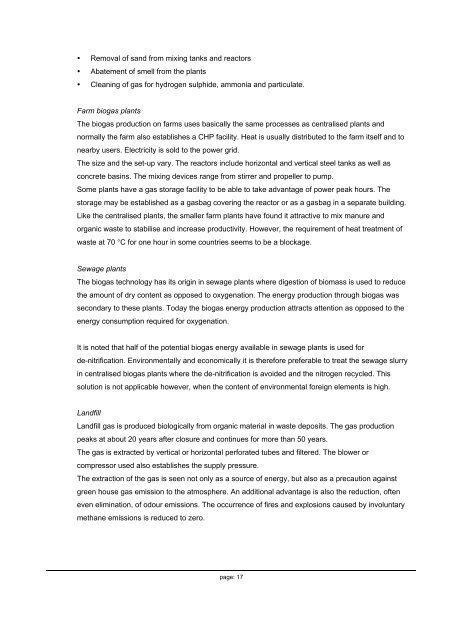Adding gas from biomass to the gas grid - SGC
Adding gas from biomass to the gas grid - SGC
Adding gas from biomass to the gas grid - SGC
- No tags were found...
You also want an ePaper? Increase the reach of your titles
YUMPU automatically turns print PDFs into web optimized ePapers that Google loves.
• Removal of sand <strong>from</strong> mixing tanks and reac<strong>to</strong>rs• Abatement of smell <strong>from</strong> <strong>the</strong> plants• Cleaning of <strong>gas</strong> for hydrogen sulphide, ammonia and particulate.Farm bio<strong>gas</strong> plantsThe bio<strong>gas</strong> production on farms uses basically <strong>the</strong> same processes as centralised plants andnormally <strong>the</strong> farm also establishes a CHP facility. Heat is usually distributed <strong>to</strong> <strong>the</strong> farm itself and <strong>to</strong>nearby users. Electricity is sold <strong>to</strong> <strong>the</strong> power <strong>grid</strong>.The size and <strong>the</strong> set-up vary. The reac<strong>to</strong>rs include horizontal and vertical steel tanks as well asconcrete basins. The mixing devices range <strong>from</strong> stirrer and propeller <strong>to</strong> pump.Some plants have a <strong>gas</strong> s<strong>to</strong>rage facility <strong>to</strong> be able <strong>to</strong> take advantage of power peak hours. Thes<strong>to</strong>rage may be established as a <strong>gas</strong>bag covering <strong>the</strong> reac<strong>to</strong>r or as a <strong>gas</strong>bag in a separate building.Like <strong>the</strong> centralised plants, <strong>the</strong> smaller farm plants have found it attractive <strong>to</strong> mix manure andorganic waste <strong>to</strong> stabilise and increase productivity. However, <strong>the</strong> requirement of heat treatment ofwaste at 70 °C for one hour in some countries seems <strong>to</strong> be a blockage.Sewage plantsThe bio<strong>gas</strong> technology has its origin in sewage plants where digestion of <strong>biomass</strong> is used <strong>to</strong> reduce<strong>the</strong> amount of dry content as opposed <strong>to</strong> oxygenation. The energy production through bio<strong>gas</strong> wassecondary <strong>to</strong> <strong>the</strong>se plants. Today <strong>the</strong> bio<strong>gas</strong> energy production attracts attention as opposed <strong>to</strong> <strong>the</strong>energy consumption required for oxygenation.It is noted that half of <strong>the</strong> potential bio<strong>gas</strong> energy available in sewage plants is used forde-nitrification. Environmentally and economically it is <strong>the</strong>refore preferable <strong>to</strong> treat <strong>the</strong> sewage slurryin centralised bio<strong>gas</strong> plants where <strong>the</strong> de-nitrification is avoided and <strong>the</strong> nitrogen recycled. Thissolution is not applicable however, when <strong>the</strong> content of environmental foreign elements is high.LandfillLandfill <strong>gas</strong> is produced biologically <strong>from</strong> organic material in waste deposits. The <strong>gas</strong> productionpeaks at about 20 years after closure and continues for more than 50 years.The <strong>gas</strong> is extracted by vertical or horizontal perforated tubes and filtered. The blower orcompressor used also establishes <strong>the</strong> supply pressure.The extraction of <strong>the</strong> <strong>gas</strong> is seen not only as a source of energy, but also as a precaution againstgreen house <strong>gas</strong> emission <strong>to</strong> <strong>the</strong> atmosphere. An additional advantage is also <strong>the</strong> reduction, ofteneven elimination, of odour emissions. The occurrence of fires and explosions caused by involuntarymethane emissions is reduced <strong>to</strong> zero.page: 17
















